Benin Art And Architecture - Culture (2) - Nairaland
Nairaland Forum / Nairaland / General / Culture / Benin Art And Architecture (207067 Views)
Art And Architecture Of The Igbo People / The Art And Architecture Of Yorubaland! / Show Pictures Of Africas Art And Archaeological Treasures (2) (3) (4)
(1) (2) (3) (4) (5) (6) (7) (8) (9) (10) ... (25) (Reply) (Go Down)
| Re: Benin Art And Architecture by PhysicsMHD(m): 8:32am On Jan 09, 2011 |
[img]http://www.artic.edu/aic/collections/citi/images/standard/Exhib/EX_000001/93587_520163.jpg[/img] Edo Benin Kingdom, Nigeria Pair of Arm Cuffs, 18th century Ivory .5: 13 x 9 cm (5 1/8 x 3 1/2 in.); .6: 13.1 x 9.1 cm (5 3/16 x 3 9/16 in.) The Trustees of the British Museum, London, Af1922,0313.5-6 An extraordinary 18th-century ivory carver made these finely detailed arm cuffs. On two sides of each cuff, the oba—accompanied by helmeted warriors—raises an eben sword, stressing his control of Benin’s military might. This imagery alternates with another group of figures that centers on a high-ranking individual, possibly the ezomo, Benin’s top war chief. He is richly dressed and also raises an eben sword. Portuguese soldiers flank him, a reference to their role as Benin’s military allies in the 16th century. |
| Re: Benin Art And Architecture by PhysicsMHD(m): 8:35am On Jan 09, 2011 |
[img]http://www.artic.edu/aic/collections/citi/images/standard/Exhib/EX_000001/101556_529049.jpg[/img] Edo Benin Kingdom, Nigeria Waist Pendant of a Leopard's Head, 17th/18th century Brass 14.5 x 10 x 5 cm (5 11/16 x 3 15/16 x 2 in.) The National Commission for Museums and Monuments, Nigeria, 47.21.4 A formidable predator with a copper-colored pelt, the leopard is a fitting counterpart to the oba and is particularly associated with his military might. Brass leopard-head waist pendants were worn as insignia by Benin’s militia. They are no longer worn in the kingdom, because it does not have a standing army. Ivory pendants were far more limited in use, belonging only to the oba or top-ranking officers such as the iyase or ezomo. The holes simulating the leopard’s spots on this example were once inlaid with brass, and bells dangled from the loops rimming its jawline. |
| Re: Benin Art And Architecture by PhysicsMHD(m): 8:37am On Jan 09, 2011 |
[img]http://www.artic.edu/aic/collections/citi/images/standard/Exhib/EX_000001/96448_520247.jpg[/img] Edo Benin Kingdom, Nigeria Double-Gong and Striker, 16th century Ivory H. 36.5 cm (14 3/4 in.) The Trustees of the British Museum, London, Af1963,04.1 and Af1964,07.1 This extremely finely carved ivory double gong—double because of the second, smaller resonating cup at its front—is an artistic tour de force. Its central image is the oba in coral regalia supported by the high priests osa and osuan, officials who tend the altars of the kingdom’s two patron gods. Today a similar ivory gong is carried by the oba during Emobo, the last of the empowering rites of the Igue festival. The oba gently taps the ivory instrument, creating a rhythmic sound to calm and dismiss unruly spirits from the kingdom. |
| Re: Benin Art And Architecture by PhysicsMHD(m): 8:39am On Jan 09, 2011 |
[img]http://www.artic.edu/aic/collections/citi/images/standard/Exhib/EX_000001/93742_520182.jpg[/img] Edo Benin Kingdom, Nigeria Box in the Shape of an Antelope Head (Orievbee), 18th century Ivory and brass 16.5 x 29 x 11.5 cm (6 1/2 x 11 3/8 x 4 1/2 in.) Staatliche Museen zu Berlin, Ethnologisches Museum, III C 7633 a, b Boxes shaped like antelope heads are usually made of wood embellished with brass sheeting. This ivory example, inlaid with brass, is unique and undoubtedly belonged to the oba. Antelope-head boxes are used as containers for kola nuts, a symbol of peace, order, and civilization that is offered to welcome honored guests. The kola nuts are broken into segments and shared among the guests by rank followed by a prayer of blessing. The antelope is appreciated for its beauty and gentleness. The hands that grasp its horns symbolize the privilege taken by humans to sacrifice the animal in sacred rituals. |
| Re: Benin Art And Architecture by PhysicsMHD(m): 8:40am On Jan 09, 2011 |
[img]http://www.artic.edu/aic/collections/citi/images/standard/Exhib/EX_000001/93708_520175.jpg[/img] Edo Benin Kingdom, Nigeria Box in the Shape of a Palace Building, 17th/18th century Brass 32 x 61 cm (12 5/8 x 24 in.) Staatliche Museen zu Berlin, Ethnologisches Museum, III C 8488 This hinged box, which most likely represents the oba’s meetinghouse, is a rare representation of a palace building. A slithering snake runs down the length of the tall central turret, and a large bird stands at its apex. These represent the massive sculptures, cast in sections, which stood as impressive markers of the powerful oba. Two figures carrying rifles stand on the rooftop facing two additional birds (one now missing). These may evoke Oba Esigie, who ordered his soldiers to shoot the Bird of Prophecy, thereby establishing his own destiny. |
| Re: Benin Art And Architecture by PhysicsMHD(m): 9:04am On Jan 09, 2011 |
 African Art / Benin Ornamental Mask of a Leopard Head - PF.5013 Origin: Southcentral Nigeria Circa: 1500 AD to 1897 AD 1 Like |
| Re: Benin Art And Architecture by PhysicsMHD(m): 9:19am On Jan 09, 2011 |
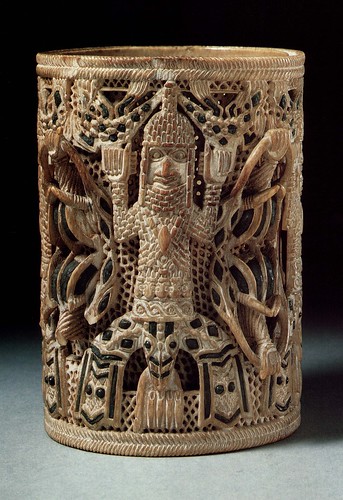 Benin Ivory armband depicting Olokun |
| Re: Benin Art And Architecture by PhysicsMHD(m): 9:22am On Jan 09, 2011 |
 Benin bronze plaque depicting a drummer |
| Re: Benin Art And Architecture by PhysicsMHD(m): 9:26am On Jan 09, 2011 |
 1 Like |
| Re: Benin Art And Architecture by PhysicsMHD(m): 9:27am On Jan 09, 2011 |
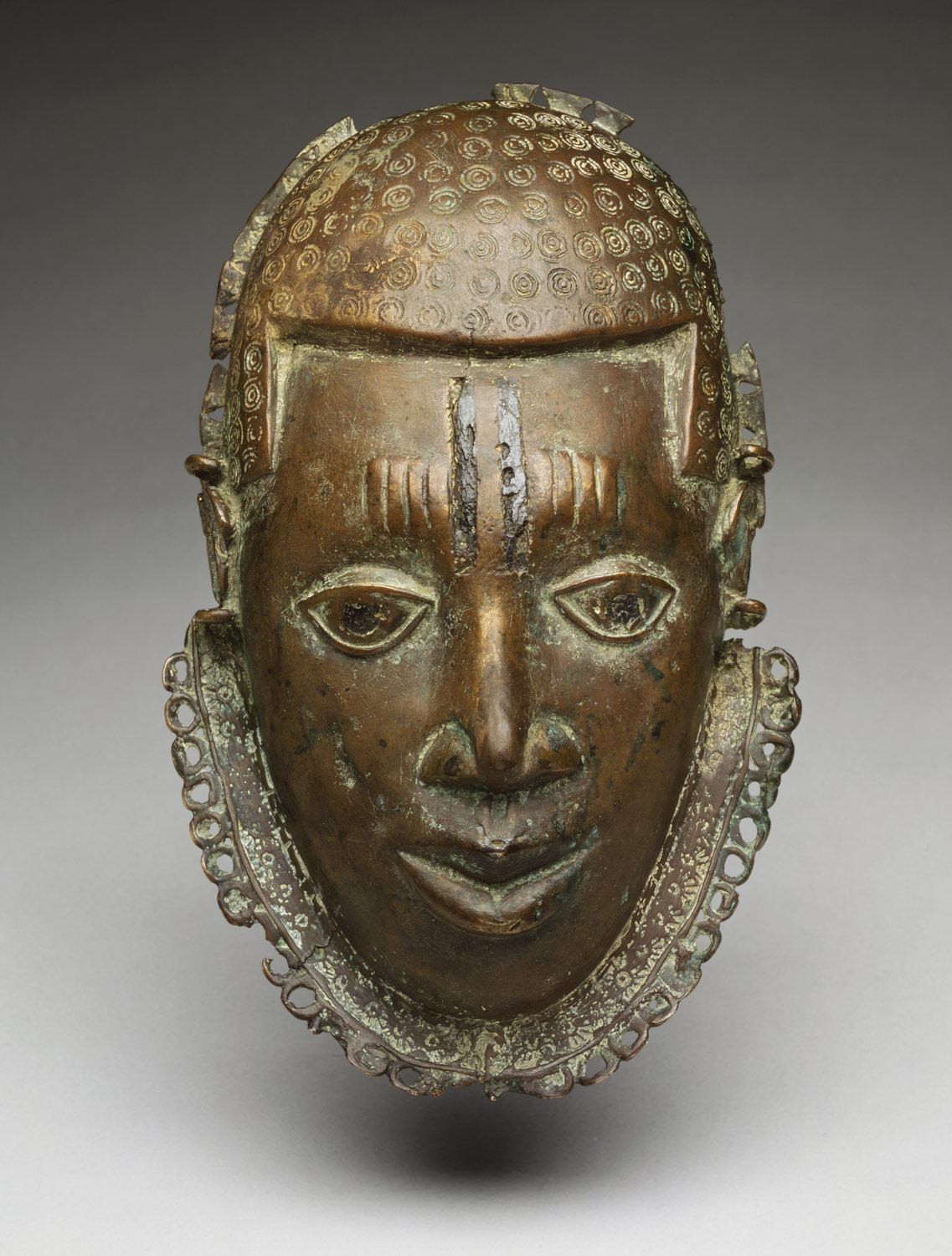 Pectoral Ornament: Face, 15th–17th century Nigeria; Edo peoples, court of Benin Brass, iron H. 7 1/2 in. (18.93 cm) Gift of Mr. and Mrs. Klaus G. Perls, 1991 (1991.17.50) Cast brass masks such as this one were owned by paramount chiefs and titleholders of the Benin kingdom. Representing the face of the oba himself, these masks were worn suspended from the neck to indicate rank and demonstrate fealty to the king. As Benin expanded its political influence and military control over many of its neighbors, those foreign rulers who were absorbed into its political system also received these masks. Created at the court by royal brass casters, such works were distributed by the oba to newly incorporated chiefs. This work is believed to have belonged to either the Amapetu of Mahin or the Olugbo of Ugbo, two Yoruba rulers approximately eighty miles to the west of Benin City. Like most pectoral masks, this work depicts a human face framed at the bottom by an ornamental flange with loops for small metal rattles. The hair, bordered by a sharply angular hairline, consists of rows of small concentric circles. Two inlaid iron vertical marks on the forehead lend balance and dignity to the face, and invest the pupils of the eyes with an intensity and power befitting a ruler. The four vertical marks to either side of these are found on Benin sculptures depicting Edo women or non-Edo men, suggesting that this work may have been created expressly for the use of a foreign ruler. The subtle molding of the nose and cheeks as well as the sensitive, delicate mouth imbue the representation with a naturalism that is stylistically associated with the earliest period of Benin sculpture, suggesting that it was created between the fifteenth and seventeenth centuries. Source: Pectoral Ornament: Face [Nigeria; Edo peoples, court of Benin] (1991.17.50) | Heilbrunn Timeline of Art History | The Metropolitan Museum of Art |
| Re: Benin Art And Architecture by PhysicsMHD(m): 9:29am On Jan 09, 2011 |
 ' 'Plaque of Chiefs in Pangolin Skin Benin Culture/West African Artist Unknown Bronze British Museum, London |
| Re: Benin Art And Architecture by PhysicsMHD(m): 9:30am On Jan 09, 2011 |
 Benin Plaque Depicting a Feline Face A repousse plaque from the Benin depicting a feline face. |
| Re: Benin Art And Architecture by PhysicsMHD(m): 9:31am On Jan 09, 2011 |
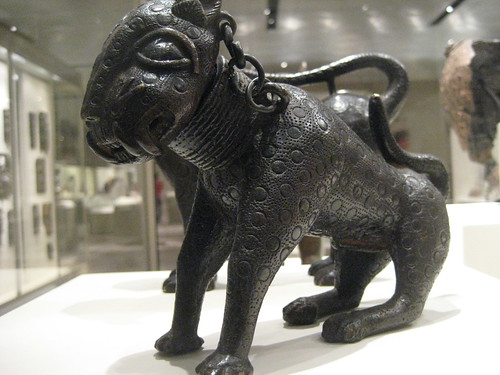 Leopard Aquamanile Nigeria, Kingdom of Benin, Edo peoples 16th - 19th century Brass |
| Re: Benin Art And Architecture by PhysicsMHD(m): 9:33am On Jan 09, 2011 |
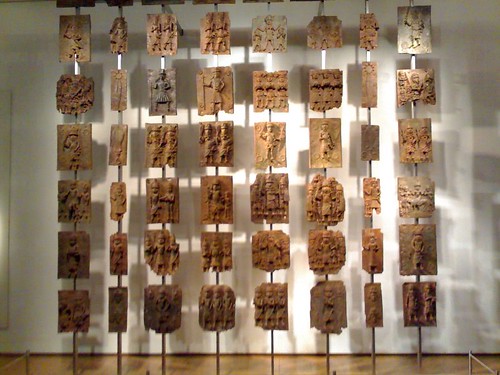 From the British Museum |
| Re: Benin Art And Architecture by PhysicsMHD(m): 9:36am On Jan 09, 2011 |
 |
| Re: Benin Art And Architecture by PhysicsMHD(m): 9:37am On Jan 09, 2011 |
 |
| Re: Benin Art And Architecture by PhysicsMHD(m): 9:38am On Jan 09, 2011 |
 |
| Re: Benin Art And Architecture by PhysicsMHD(m): 9:41am On Jan 09, 2011 |
 Warriors holding their ceremonial swords. Sculpture of the Benin Kingdom. Bronze, 16th-18th century, Nigeria. H. 40 cm (15 ½ in.), 33 cm (12 ¾ in.) deposit from the Musée national des arts d'Afrique et d'Océanie |
| Re: Benin Art And Architecture by PhysicsMHD(m): 9:44am On Jan 09, 2011 |
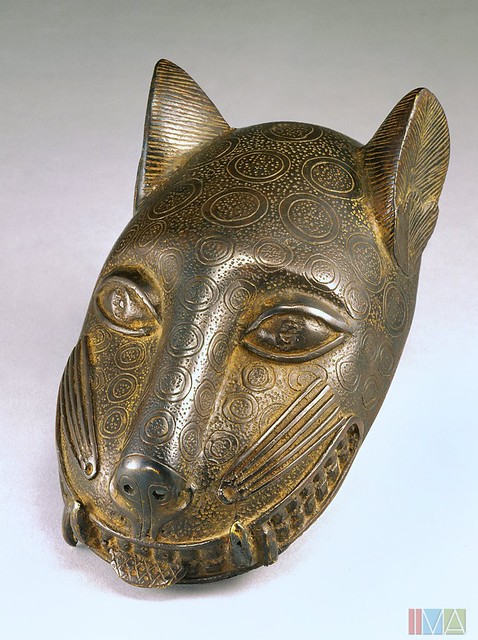 Nigeria - Edo Vessel Lid in the Form of a Leopard Head (Indianapolis Museum of Art) Nigeria Edo people Creation date: 1501-1600 Materials: brass Dimensions 7 3/4 x 4 1/4 x 2 1/2 in. "The regal face of the leopard inspired this cast brass lid, an excellent instance of an early work from the Kingdom of Benin, combining a refined naturalism with an ornamental surface treatment. Tthe entire surface is covered with detailed designs consisting of concentric circles, interlocking teeth, and patterns within patterns. The status of the object is evident in both the prestigious metal of which it is made and the representation of the leopard, a powerful animal with royal associations. Functionally, this lid would have covered a container used to store small items, such as kola nuts, beads, or shells. Though the exact dates of Benin objects are unknown, two clues to the early production of this piece are the lid’s stylistic similarity to castings of full leopard bodies at this time and the thinness of the metal. Thinner casts indicate a paucity of copper, a component of brass, which was scarce before the Edo increased trade with the Portuguese." |
| Re: Benin Art And Architecture by PhysicsMHD(m): 9:47am On Jan 09, 2011 |
 Benin bronzes at the Horniman Museum. |
| Re: Benin Art And Architecture by PhysicsMHD(m): 9:48am On Jan 09, 2011 |
 Benin bronze at the Horniman Museum. |
| Re: Benin Art And Architecture by PhysicsMHD(m): 9:53am On Jan 09, 2011 |
 |
| Re: Benin Art And Architecture by FACE(m): 10:57am On Jan 09, 2011 |
Very interesting. Enough artworks to start a massive museum. I think the Edo govt should start trying to recover all the works and restoring old buildings if any is still standing with a view to starting a tourist museum - a good money spinner. |
| Re: Benin Art And Architecture by PhysicsHD: 12:28am On Jan 10, 2011 |
Akhenaten: I had actually already responded to this post yesterday, but I included a long piece of an article that talked about the habitual depopulation of Benin due to war campaigns and in-fighting, so the spambot deleted the post. However the other part of what I said was: "I suspect that the Bini were just a smaller section of whatever group most of Southern Nigeria came out of, like the Idoma, Igala, Ijaw, etc. . . compared to Igbo and Yoruba. But another thing to consider is that Bini diverged from other groups such as the other groups in Edo state some of which may have come from Benin city hundreds of years ago. There are also groups like Edo-Akure, and some other Ondo Edos who identify as Yorubas now, and a few more such people in Lagos. However the most convincing argument to me comes from just looking at it in terms of math: If the population of Bini at one point is 1 million, and the population of Yoruba in Nigeria is 7-8 million at one point and both groups multiply by around 3.5 (the same rate of reproduction of Bini people and Yoruba people) over six decades, the Bini would only be 3.5 million while the Yoruba would be 24.5 - 28 million, and what started as only a 6-7 million difference becomes a 21 - 24.5 million difference, and we are left dumbfounded when there is actually nothing out of the ordinary in this. If we have 1 million Bini at one point and 6 million Igbo and Bini multiply by 3.5 and Igbo by 4 (only a slightly greater reproduction rate) over six decades we only have 3.5 million Bini but have 24 million Igbo. There was originally a 5 million difference, but it becomes 20.5 million. There is nothing bizarre about this in reality." Which I think makes a fair amount of sense. |
| Re: Benin Art And Architecture by PhysicsHD: 12:30am On Jan 10, 2011 |
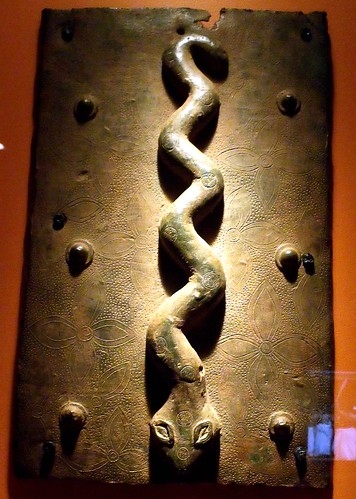 Plaque de bronze avec un serpent Fin XVIe siècle, Bronze, 47 x 30 cm, Provenance : Bénin, Nigéria, Musée d'Ethnographie, Stockholm |
| Re: Benin Art And Architecture by PhysicsHD: 12:32am On Jan 10, 2011 |
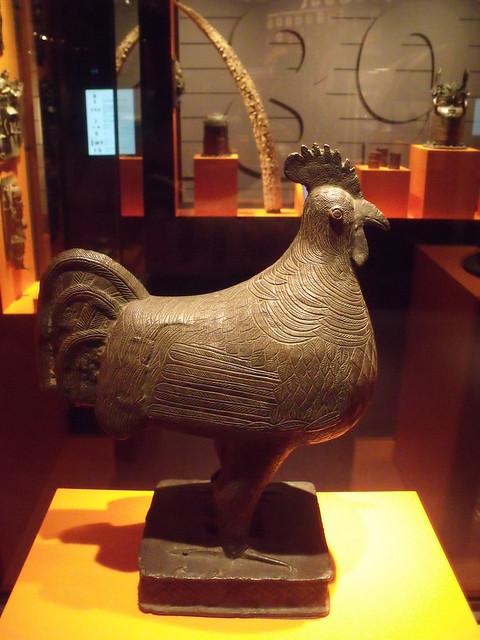 Coq de bronze XVIIIe siècle, Bronze, 30,5 x 40 x 15 cm, Provenance : Bénin, Nigéria, Musée Ethnographique, Stockholm |
| Re: Benin Art And Architecture by PhysicsHD: 12:34am On Jan 10, 2011 |
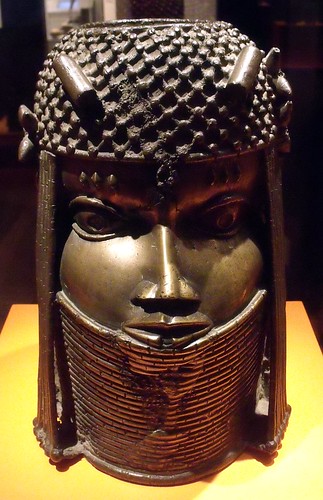 Tête en bronze commémorative d'un chef Oba destiné à un autel des ancêtres dans le palais royal XVIIe siècle, Bronze, Provenance : Palais Royal, Etat d'Edo, Bénin, Nigéria 22 x 30,5 21 cm, Musée Ethnographique, Stockholm |
| Re: Benin Art And Architecture by PhysicsHD: 12:36am On Jan 10, 2011 |
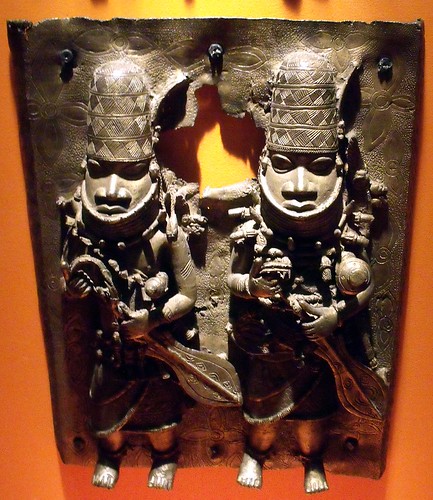 Plaque de bronze avec deux guerriers Fin XVIIe siècle, Bronze, 44,5 x 34 cm, Provenance : Bénin, Nigéria, Musée Ethnographique, Stockholm |
| Re: Benin Art And Architecture by PhysicsHD: 12:39am On Jan 10, 2011 |
[img]http://161.58.35.145/wch/gallery/Quarter1/African/09-Benin-Culture,-Plaque-with-Leopard-Totemistic-Relationshi.jpg[/img] Benin Culture Plaque with Leopard |
| Re: Benin Art And Architecture by PhysicsHD: 12:41am On Jan 10, 2011 |
[img]http://161.58.35.145/wch/gallery/Quarter1/African/11-Benin-Culture,-Ceremonial-Totemism,-from-Nigeria,-c.-17th.jpg[/img] Benin Culture 17th Century |
| Re: Benin Art And Architecture by PhysicsHD: 12:42am On Jan 10, 2011 |
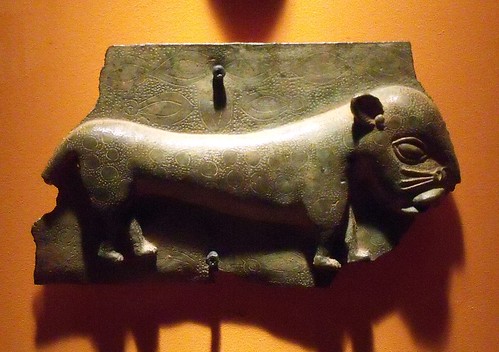 Plaque au léopard Début XVIIe siècle, Bronze, 16,5 x 29 cm, Provenance : Bénin, Nigéria, Musée Ethnographique, Stockholm |
| Re: Benin Art And Architecture by PhysicsHD: 12:45am On Jan 10, 2011 |
 |
(1) (2) (3) (4) (5) (6) (7) (8) (9) (10) ... (25) (Reply)
20 Popular Yoruba Charms And Their Uses(With Direct English Translations) / HAUSALAND: Teach Me Hausa / The Culture Lounge
(Go Up)
| Sections: politics (1) business autos (1) jobs (1) career education (1) romance computers phones travel sports fashion health religion celebs tv-movies music-radio literature webmasters programming techmarket Links: (1) (2) (3) (4) (5) (6) (7) (8) (9) (10) Nairaland - Copyright © 2005 - 2024 Oluwaseun Osewa. All rights reserved. See How To Advertise. 53 |